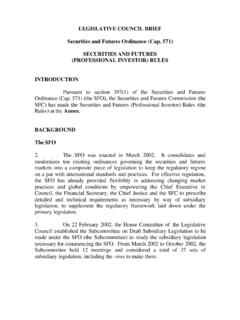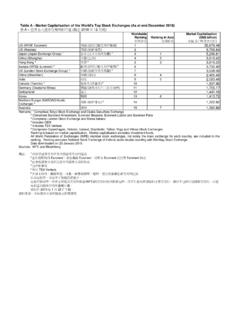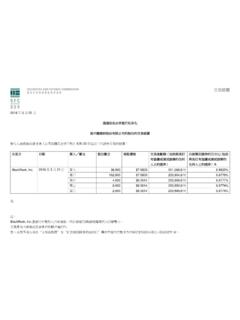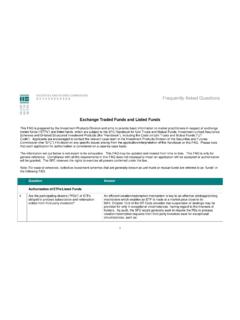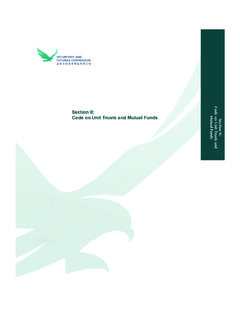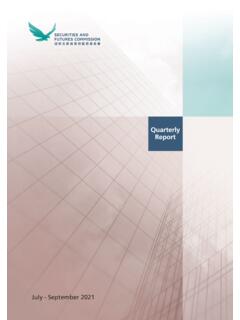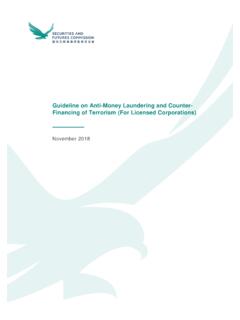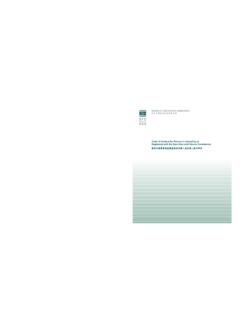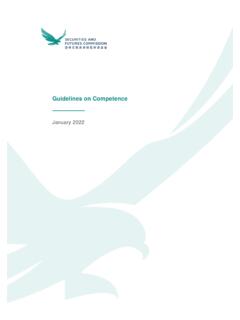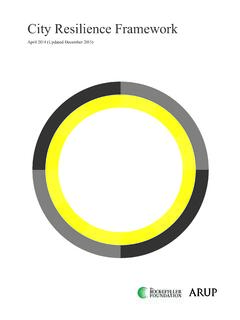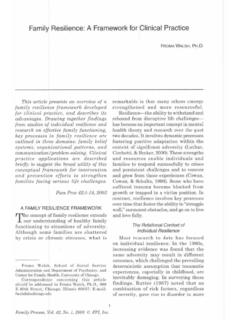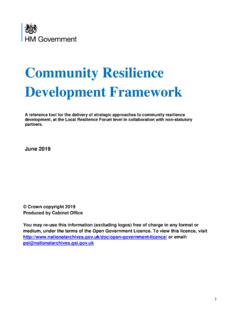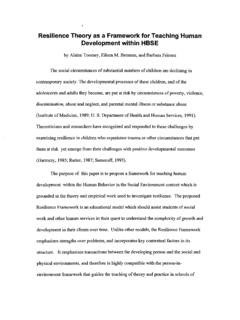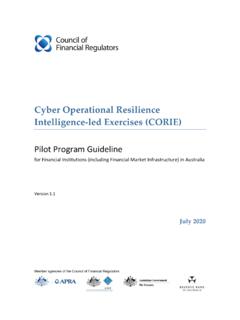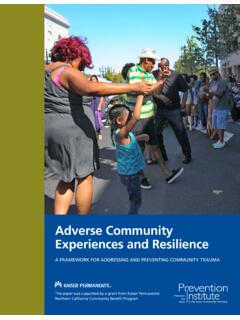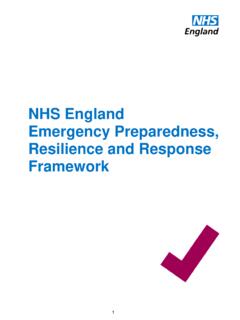Transcription of Report on Operational Resilience and Remote Working ...
1 Report on Operational Resilience and Remote Working Arrangements October 2021. Contents Introduction 3. Operational Resilience Standard 1: Governance 5. Standard 2: Operational risk management 7. Standard 3: Information and communication technology including cybersecurity 9. Standard 4: Third-party dependency risk management 11. Standard 5: Business continuity plan and incident management 12. Remote Working Governance 15. Off-premises trading 18. Outsourcing and third-party arrangements 20. Information security 21. Cybersecurity 22. Record keeping 23. Notification obligation 23. Working -from-home arrangements 24. 2. Introduction 1. During the COVID-19 pandemic, the Securities and Futures Commission (SFC) held extensive supervisory discussions with licensed corporations on: Split-team arrangements to maintain business as usual of critical operations and services in the event office and business locations were inaccessible or of other pandemic-related disruptions.
2 Working -from-home (WFH) arrangements and compliance with conduct requirements; and Operational Resilience to cope with market dislocations and pandemic-related disruptions. 2. We noted that licensed corporations exhibited a strong level of Resilience which helped them maintain business as usual during the pandemic. Remote Working , particularly WFH, was found to be part of many licensed corporations' business continuity strategies. 3. We also observed that the SFC's guidance on cybersecurity, business continuity plans, internal controls and risk management in its codes, guidelines and circulars 1 has helped licensed corporations maintain Resilience . 4. To ensure continued strength, it is important for intermediaries to adopt a comprehensive approach to achieve their Operational Resilience objectives based on common established standards. These include their ability to prevent, adapt and respond to and recover and learn from Operational disruptions.
3 5. In addition, as Remote Working , particularly WFH, is likely to remain popular even after the pandemic is under control, intermediaries should be vigilant about the risks associated with Remote Working and implement appropriate risk management measures and internal controls to address these risks. 6. To these ends, in addition to discussing our supervisory observations, this Report : (a) lays down Operational Resilience standards and required implementation measures which supplement the SFC's existing guidance. Suggested techniques and procedures as well as case examples and lessons learned drawn from our review of some licensed corporations' Operational Resilience plans and measures 1 For example, the Code of Conduct for Persons Licensed by or Registered with the Securities and Futures Commission (Code of Conduct), Fund Manager Code of Conduct, Management, Supervision and Internal Control Guidelines for Persons Licensed by or Registered with the Securities and Futures Commission (Internal Control Guidelines), Circular to All Licensed Corporations on Alerts for Ransomware Threats issued on 15 May 2017, Circular to Intermediaries on Receiving Client Orders through Instant Messaging issued on 4 May 2018 and Circular to Licensed Corporations on Management of Cybersecurity Risks Associated with Remote Office Arrangement issued on 29 April 2020.
4 3. during the COVID-19 pandemic and other disruptive events are also provided;. and (b) sets out the expected regulatory standards for managing some major possible risks of Remote Working and provides suggested techniques and procedures to assist intermediaries' compliance with these standards. 7. While there may be alternative ways to achieve Operational Resilience objectives and mitigate the risks of Remote Working , intermediaries are encouraged to adopt the suggested techniques and procedures as appropriate to their circumstances. Registered institutions should comply with all applicable requirements and should also make reference to other guidance issued by the Hong Kong Monetary Authority (HKMA) from time to time. 4. Operational Resilience 1. Intermediaries are exposed to a wide range of disruptive events which may affect their operations. These events range from the breakdown of a single computer, which affects an individual staff member's ability to provide services, to cybersecurity incidents or pandemics, which can lead to a wide-scale disruption of an intermediary's activities.
5 2. Some disruptions are unavoidable. Therefore, intermediaries should have a proper framework in place to identify, prepare for, respond and adapt to disruptive incidents. 3. This section sets out a set of Operational Resilience standards and required implementation measures for attaining these standards. 4. To assist intermediaries in complying with the Operational Resilience standards and required implementation measures, we have also provided some suggested techniques and procedures as well as case examples and lessons learned drawn from our supervisory observations. 5. Intermediaries may wish to consider whether the suggested techniques and procedures and practices are applicable to their own circumstances. In any event, intermediaries should implement all necessary policies, procedures and controls which are commensurate with their business size and complexity, and effective for complying with the Operational Resilience standards and required implementation measures.
6 Operational Resilience standard 1: Governance Operational Resilience standard 1. Intermediaries should have an effective governance framework in place to set their Operational Resilience objectives, develop, implement and oversee arrangements and measures to identify on an ongoing basis disruptive incidents which may affect the sound, efficient and effective operations of their business 2, and respond and adapt to disruptive incidents. Required implementation measures Intermediaries' senior management assume full responsibility for setting Operational Resilience objectives and developing and implementing the necessary arrangements and measures 3. Designated staff members should monitor the ongoing Operational Resilience of the intermediary's business units in support of the senior management's oversight. 2 Part I of the Internal Control Guidelines. 3 Paragraph I(1) of the Internal Control Guidelines. 5. The senior management should be provided with sufficient information to enable them to continually and in a timely manner assess matters which may affect the intermediary's Operational Resilience 4 and consider and approve any necessary adjustments to its Operational Resilience efforts.
7 Suggested techniques and procedures 6. Senior management oversight arrangements are put in place to: (a) identify disruptive scenarios related to internal processes, people, systems, external threats and third parties which may affect the intermediary's ability to continue to conduct business activities or provide services;. (b) review and approve the intermediary's risk tolerance for disruptions to its business operations by senior management, having regard to its risk profile and the capabilities of various Operational environments, including systems, processes, people, IT infrastructure and risk management, to support Operational Resilience ; and (c) develop and implement effective and resilient systems and controls for maintaining business activities and services which are consistent with the intermediary's tolerance for disruption. Case examples 7. Some firms assigned senior management, responsible officers or department heads to be responsible for identifying and reviewing critical functions and systems and updating written business contingency plans annually or whenever there is a change to services, systems or staff.
8 They also ensured that their business contingency plans properly covered potential disruptive events and the corresponding response measures, giving higher priority to critical functions and systems such as those related to trading and settlement. 8. The senior management of a firm regularly reviewed the implementation measures for adapting to disruptive incidents to ensure that these measures could enable the firm to carry out its business in an efficient and effective manner. For example, at the onset of the COVID-19 pandemic, the firm adopted split-site operations to physically segregate staff among the firm's office premises, recovery site and home offices. Staff were required to work at their designated work locations for multiple weeks before rotation to minimise the potential impact of a confirmed COVID-19 infection in any of these work locations. Upon review, the firm found that the split-site operations created obstacles to effective communication among staff and promptly shortened the rotation cycle.
9 This gave managers greater flexibility in managing workload, promoted better communication and accommodated staff's personal needs. 4 Paragraph I(2) of the Internal Control Guidelines. 6. 9. During the pandemic, a firm experienced resource constraints and some audit reviews could not be conducted as scheduled. In response, the firm set up an assessment committee to identify key risk areas in its operations and prioritise reviews of these areas which included Operational Resilience and WFH (including off-premises trading). The prioritised reviews were conducted by leveraging resources available from the firm's first and second lines of defence and provided assurances to management with respect to its ability to conduct business efficiently and effectively during the COVID-19. disruptions. In addition, requests to defer audit reviews were assessed and approved by the Board so as to ensure that they were justified and the corresponding risks arising from any delays in conducting the reviews were properly addressed.
10 Operational Resilience standard 2: Operational risk management Operational Resilience standard 2. Intermediaries should have an effective Operational risk management framework in place to assess the potential impact of disruptions on operations (including people, processes and systems) and compliance matters and manage the resulting risks in accordance with their Operational Resilience objectives. Required implementation measures Intermediaries should establish and maintain effective policies and procedures to ensure the proper management of Operational risks to which they are exposed 5. They should also conduct comprehensive reviews at suitable intervals to ensure that the risk of losses resulting from Operational disruptions is maintained at acceptable and appropriate levels 6. Suggested techniques and procedures 10. An Operational risk management framework may include the following: (a) the types of Operational and regulatory risks posed by potential disruptions and the approach to monitoring and mitigating these risks.
